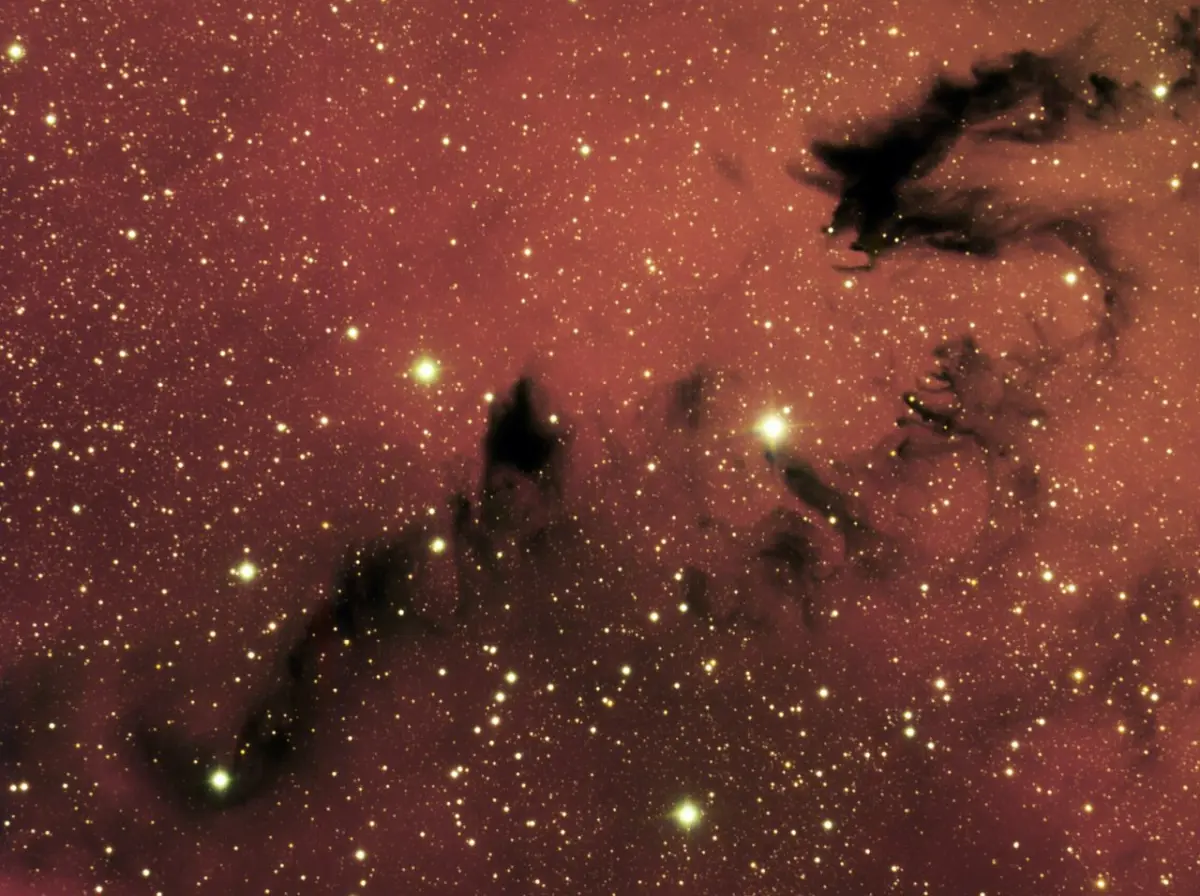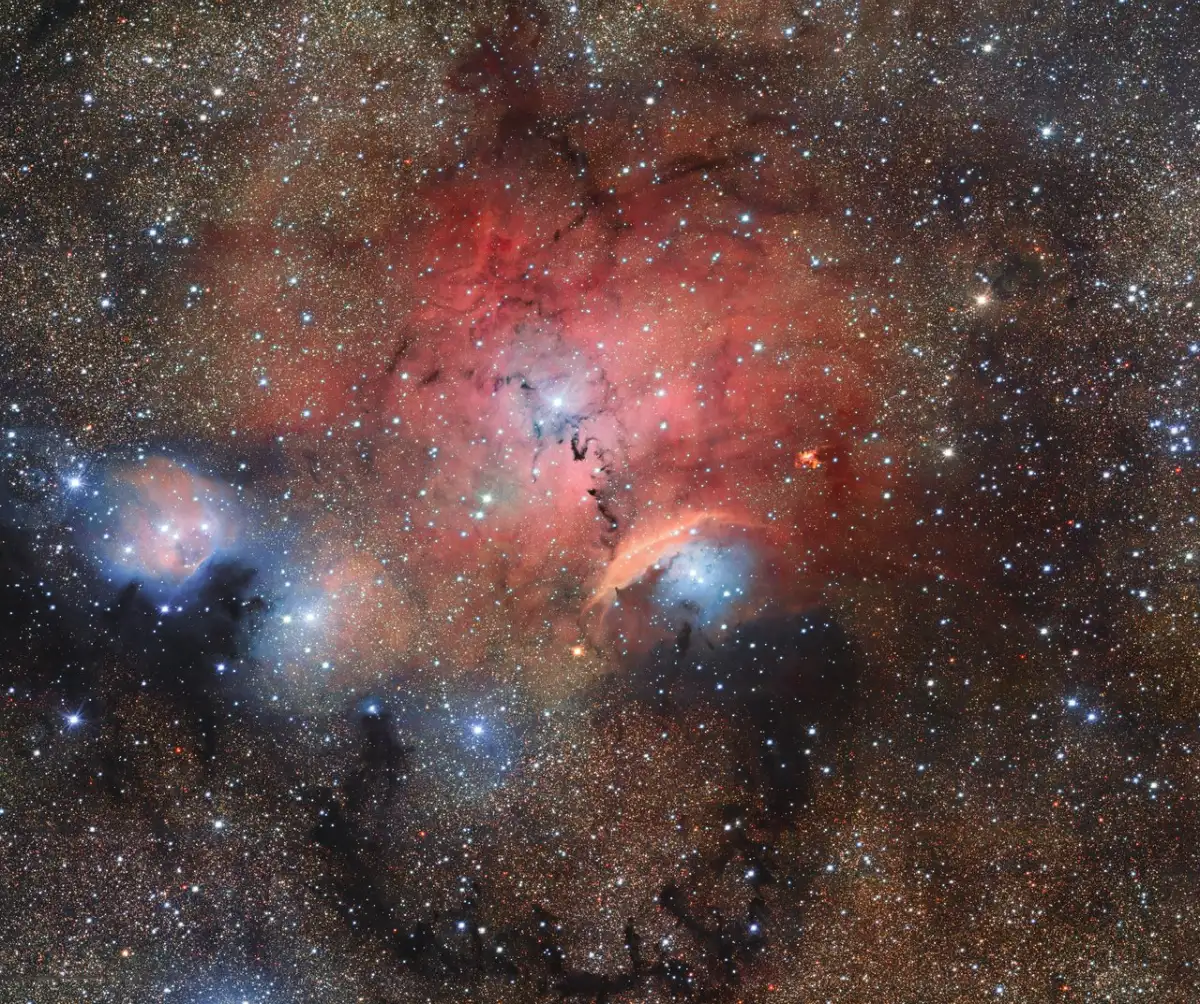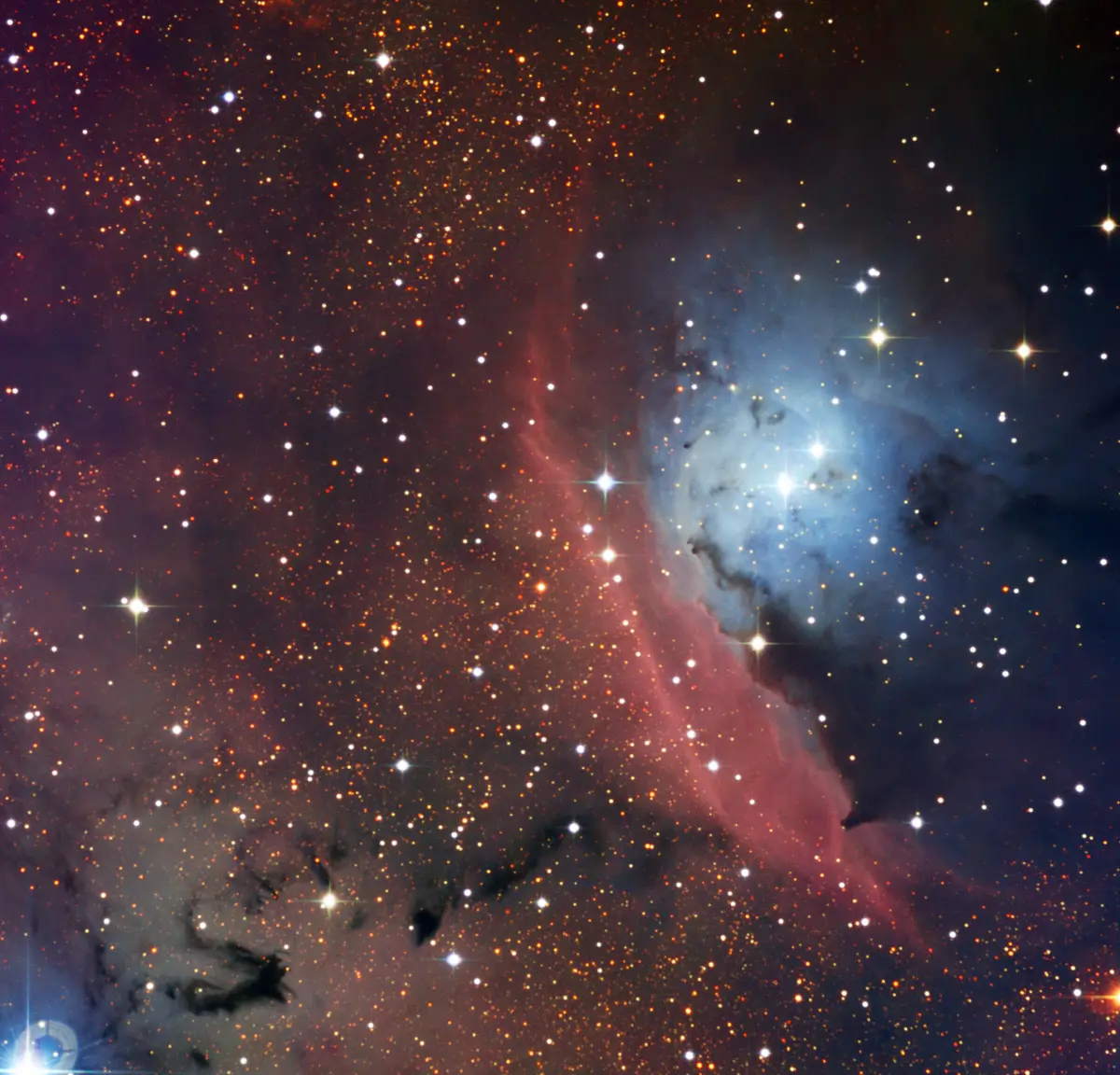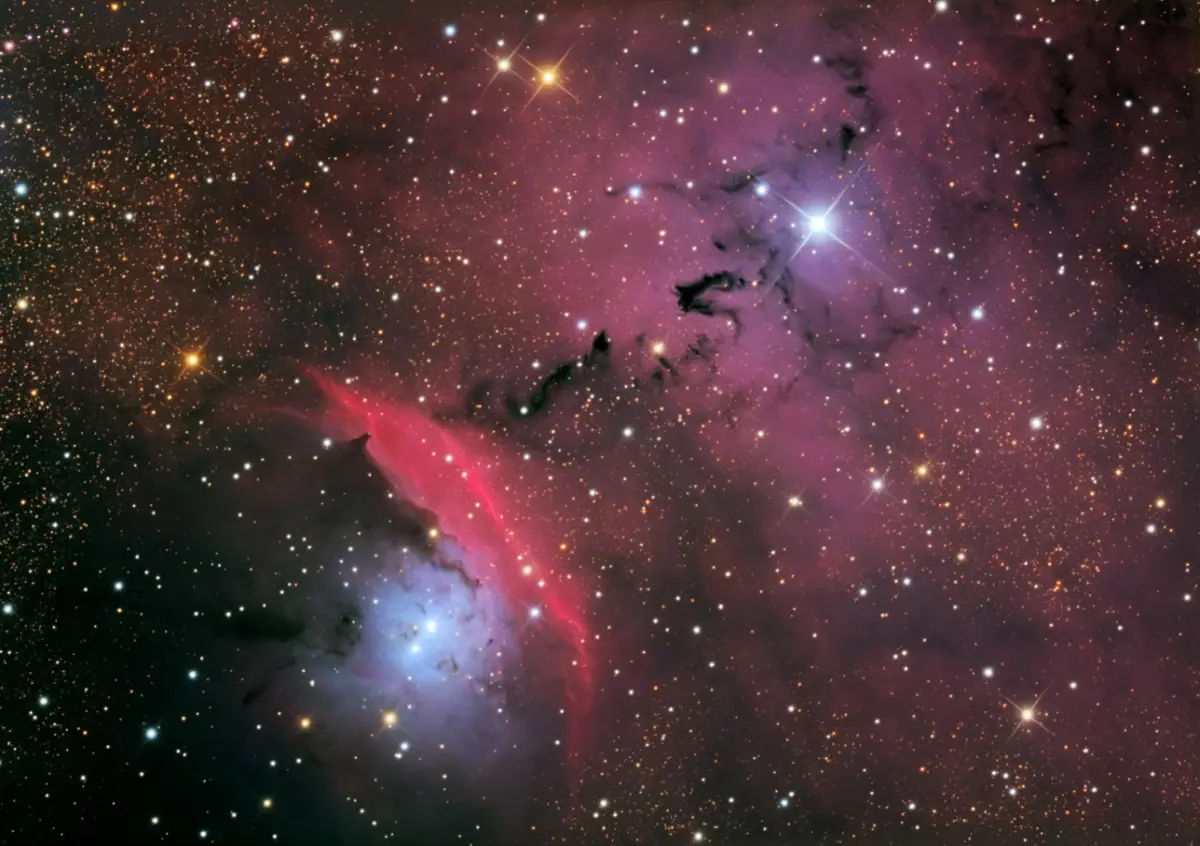The Chinese Dragon Nebula is a star-forming region located approximately 5,000 light years away in the constellation Sagittarius (the Archer). It is part of the larger H II region Simeis 188. The nebula is listed as NGC 6559 in the New General Catalogue.
Composed of both emission and reflection regions, the stellar nursery is only 15 light-years across. It appears close to the larger and brighter Lagoon Nebula (Messier 8) and Trifid Nebula (Messier 20). However, NGC 6559 lies at a much greater distance. The Lagoon and Trifid nebulae lie 4,100 light-years away.
The Chinese Dragon Nebula is lit by the energy of hot young stars that formed within its clouds. These luminous, recently formed stars are less than 2 million years old. They are responsible for the nebula’s diffuse red glow. Their intense ultraviolet light excites the nebular hydrogen gas, making it emit its own light.

Gemini South image of dragon-like dark nebula NGC 6559. NGC 6559 is a relatively small, nearby dust cloud in our Milky Way galaxy. NGC 6559 is part of a larger star-forming region in the southern constellation Sagittarius. The dark structure that resembles a Chinese dragon is caused by cool dust that absorbs background radiation from hydrogen gas that glows in red light due to ionization from nearby stars. The intricate details and wispy structure in the dark cloud is determined by turbulence flow dynamics influenced by variables such as nearby star radiation and motions of other nearby gas and dust. These kinds of clouds illustrate how past generations of stars are dispersing heavier elements into our galaxy, material that will seed future generations of stars and possibly planetary systems. Image credit: International Gemini Observatory (CC BY 4.0)
The patches of blue reflection nebulosity are the result of tiny, solid particles of dust reflecting and scattering the blue light of the bright stars in the vicinity. At the same time, the powerful stellar winds from the young stars are eroding the nebula’s clouds of ionized gas and producing intricate shapes best seen in long-exposure photographs.
NGC 6559 also contains patches of dark absorption nebulosity. Composed of dense clouds of dust, these dark patches block the light of the stars and other objects in the background.
The prominent dark cavity in the glowing region of the red emission nebula was carved out by a hot young binary system. The cavity will keep expanding as the high-energy radiation of the young stars keeps sweeping the surrounding interstellar material and making it pile up along the border of the cavity.
The young binary system has the Flamsteed designation 11 Sagittarii and the variable star designation V3903 Sagittarii. It is classified as an eclipsing binary star. Its brightness has been reported to vary from magnitude 7.00 to 7.45, below unaided eye visibility.
11 Sagittarii is composed of two massive blue main sequence stars with the spectral types O7V(n)z and B0:V. The Algol-type eclipsing binary system has an orbital period of 1.744204 days. The components have masses 27.27 and 19.01 times that of the Sun and are 122,000 and 45,500 times more luminous than the Sun. Both stars are very fast spinners, with projected rotational velocities of 230 and 170 km/s. They are believed to be only 1.6 million years old. The star system appears 0.6° northeast of NGC 6559.
The Chinese Dragon Nebula is the brightest portion of the large H II region Simeis 188. The star formation region also includes dark nebulae LDN 227 and LDN 210, the H II regions IC 1274 and IC 1275, and the reflection nebula IC 4684.
The massive young stars in the Chinese Dragon Nebula will not live very long lives. Many of them will go out as supernovae within the next several tens of millions of years. By that time, the clouds of NGC 6559 will have been swept away and only an open cluster of brilliant hot young stars will be visible in the region.

The OmegaCAM imager on ESO’s VLT Survey Telescope has captured this glittering view of the stellar nursery called Sharpless 29. Many astronomical phenomena can be seen in this giant image, including cosmic dust and gas clouds that reflect, absorb, and re-emit the light of hot young stars within the nebula. Credit: European Southern Observatory/M. Kornmesser (CC BY 4.0)
Facts
The Chinese Dragon Nebula was discovered by the English astronomer John Herschel on July 1, 1826. Herschel spotted the nebula using his 18.3-inch reflector. He listed it as h 1996 in his Slough Catalogue of 1833. He later observed the nebula from South Africa and catalogued it as h 3733. In 1864, Herschel included the nebula in his General Catalogue of Nebulae and Clusters of Stars of 1864 as GC 4384, noting “very faint, very large, a little extended, double star involved.”
Danish astronomer John Louis Emil Dreyer included the nebula as NGC 6559 in his New General Catalogue of 1888.
Several other nebulae that comprise Simeis 188 – IC 1274, IC 1275 and IC 4685 – were discovered by Grigory Abramovich Shajn and Vera Fedorovna Gaze at the Simeiz Observatory in Crimea in 1952. The astronomers included the large emission nebula on their list of galactic emission nebulae. This is how the nebula got the catalogue designation Simeis 188.
The star forming complex was catalogued as Sharpless 29 (Sh2-29), Sharpless 31 (Sh2-31) and Sharpless 32 (Sh2-32) by the American astronomer Stewart Sharpless based on a study of photographic plates from the Palomar Observatory Sky Survey in the 1950s.

This very rich region of the Milky Way in the constellation of Sagittarius (The Archer) includes huge numbers of stars as well as several spectacular regions of star formation. At the centre lies Sharpless 29, which includes NGC 6559. To the right lies the very bright and famous Lagoon Nebula (Messier 8) and at the upper-right the Trifid Nebula (Messier 20) can be seen. This picture was created from images in the Digitized Sky Survey 2. Credit: ESO/Digitized Sky Survey 2; Acknowledgement: Davide De Martin (CC BY 4.0)
Location
The Chinese Dragon Nebula is located in the western part of the southern constellation of Sagittarius. It can be found 1.4° east of its famous neighbour, the Lagoon Nebula (Messier 8).
The Lagoon Nebula can be located by drawing a line from Nunki (Sigma Sagittarii) through Kaus Borealis (Lambda Sagittarii) in the Teapot and extending it by about the same distance as that between the two stars. The Chinese Dragon Nebula appears between the larger Lagoon and the faint orange giant star 1 Sagittarii (mag. 4.96).

Location of the Chinese Dragon Nebula (NGC 6559), image: Stellarium
Several other deep sky objects appear in the same area. The relatively bright globular cluster NGC 6544 lies less than a degree southeast of the Lagoon Nebula. The cluster is on the Herschel 400 list and can be observed in amateur telescopes.
The open cluster Messier 21 (Webb’s Cross) appears 2.5° northwest of the Lagoon. The reflection nebula NGC 6526 lies between the Lagoon and Trifid nebulae, and the open cluster NGC 6546 appears roughly halfway between Messier 21 and the Chinese Dragon Nebula. The nebulae IC 1275, IC 4685 and IC 4678 appear north of NGC 6559.

The Chinese Dragon Nebula, Lagoon Nebula, Trifid Nebula, Messier 21 and NGC 6544, image credit: ESO/Digitized Sky Survey 2 (CC BY 4.0)
Chinese Dragon Nebula – NGC 6559
| Constellation | Sagittarius |
| Object type | H II region |
| Right ascension | 18h 09m 56.8s |
| Declination | −24° 06′ 23″ |
| Apparent size | 10’ x 7’ |
| Distance | 5,000 light-years (1,533 parsecs) |
| Size | 15 light-years |
| Names and designations | Chinese Dragon Nebula, NGC 6559, ESO 521-40, LBN 28, LBN 007.03-02-26 |
Images

The Danish 1.54-metre telescope located at ESO’s La Silla Observatory in Chile has captured a striking image of NGC 6559, an object that showcases the anarchy that reigns when stars form inside an interstellar cloud. This region of the sky includes glowing red clouds of mostly hydrogen gas, blue regions where starlight is being reflected from tiny particles of dust and also dark regions where the dust is thick and opaque. Image credit: ESO (CC BY 4.0)

Chinese Dragon Nebula, image credit: Adam Block/Mount Lemmon SkyCenter/University of Arizona (CC BY-SA 3.0 US)

Few regions of nebulosity show the variety of color and detail that this small region around NGC 6559 does. At the left of this image wispy dark clouds hang delicately in the foreground of diffuse glowing hydrogen gas. These lead further toward a very bright, red arc of gas that seems to shield luminous and hot stars beneath it. Presumably the birth and subsequent energetic radiative output of these stars causes the gas to glow very brightly. Even though these stars have strived to push away all of the gas and dust near them, thicker portions remain (the mountains of dark nebulosity) and continue to scatter light which color the area with hints of blue and purple. NGC 6559 can be found in most wide-field images of the Lagoon Nebula. Also be certain to visit IC 1274 as it is a related glowing gas cloud to this complex. This image was taken as part of Advanced Observing Program (AOP) program at Kitt Peak Visitor Center during 2014. Credit: KPNO/NOIRLab/NSF/AURA/John and Christie Connor/Adam Block (CC BY 4.0)